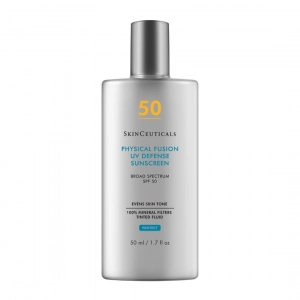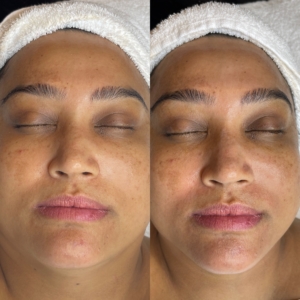Do you struggle with Hyperpigmentation?
Hyperpigmentation is a common condition where certain areas of the skin appear darker than others. It occurs when extra melanin forms in the skin, resulting in patches that may look brown, black, gray, red or pink. There are a variety of factors that can contribute to changes in pigmentation, including hormonal events such as puberty or pregnancy, injury to the skin, side effects from certain medications or, quite simply, genetics.
Pigmentation concerns are one of the most frequent conditions we treat in our esthetic rooms, so we’re going to take you along on our client’s journey to treat her Hyperpigmentation concerns.
Treating Melasma
Client Information:
Age: 43
Fitzpatrick phototype: 5
Concerns: Melasma and dark spots that occurred after pregnancy
Our client came to us concerned with Melasma (brown or blue-gray patches or freckle-like spots) and dark spots that occurred after pregnancy, which has resulted in hormonal hyperpigmentation on her cheeks, forehead and around her mouth. She is also experiencing general dullness and dehydration overall.
She would like to minimize these pigmentation concerns and have brighter, glowing, skin.
Clinical Renewal Facial
We decided to start her treatment with a Clinical Renewal Facial. This customized treatment takes specific client concerns into consideration when building out the treatment protocol. For this particular scenario, we chose a number of products to work towards her goals.
Step One – Cleanse
We started by double cleansing the skin using DerMed Brightening Cleanser which is formulated with Kojic and L-Lactic Acids to even the skin tone for a revitalized, luminous complexion while helping to prep the skin for a gentle peel.
Step Two – Peel
We followed this cleansing process by applying a Mandelic Acid Peel, which uses Kojic and Azelaic acid to exfoliate and brighten the skin. While we will not reverse the client’s concern with this one treatment, it will start the process of bringing up old pigmented skin cells while stimulating the growth of new cells.
Step Three – Finishing Products
We topped off our client’s first treatment with CE Ferulic Acid Serum from SkinCeuticals, which is a daytime Vitamin C serum that delivers advanced environmental protection, reduces inflammation while also brightening the skin.
Step Four – SPF
To ensure that our client’s newly treated skin is protected from harmful UV exposure, our final step was to apply SkinCeuticals Physical Fusion SPF 50 directly to her areas of concern.
Step Five – Home Care
With any customized skin program, homecare is essential, especially when we are treating melasma. As a result, we have recommended that our lovely client wear Skinceuticals Physical Fusion SPF 50, CE Ferulic Acid Serum and Discoloration Defense every day to help maintain the effectiveness of today’s treatment.
Next Steps
When it comes to hyperpigmentation, it is important to remember that treating this condition is a multi-treatment process. Results take time and may appear minimal after the first few treatments, as you can see in this side by side comparison, however with time and at home maintenance, you will see amazing results!
Make sure to stay tuned for our client’s next step in the process to treat her hyperpigmentation concerns, which will include LED lightwave therapy to help calm the skin and suppress excess pigment.










